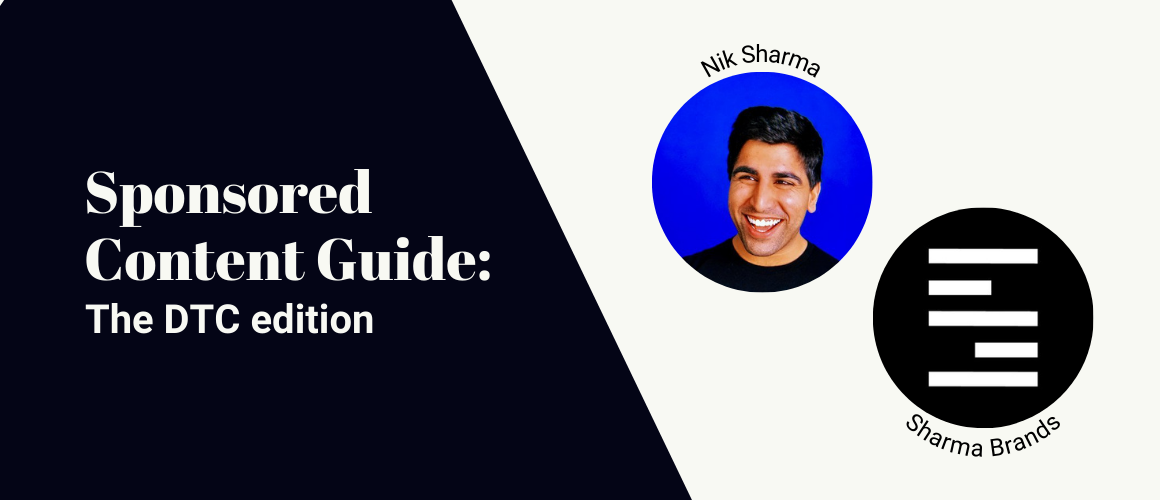At first glance, a sponsored content campaign linking to an article instead of a direct response landing page seems like a lost opportunity. After all, you've already gotten someone to click on your ad, so why wouldn't you try to close the deal with a beautifully designed and well-optimized landing page?
The answer is simple. People are looking for entertainment on these websites, not ads.
Think about it, when you're scrolling through a publisher site— Digg, BuzzFeed, Refinery29, etc.— you're there to consume content. Articles, videos, quizzes, and everything in between. So clicking on an interesting post that doesn't direct you to this type of content can fall flat.
In short, you were expecting a completely different experience than the one you got.
That's why as a DTC brand, you should be integrating an article-driven sponsored content approach into your strategy. While it might seem counterintuitive, this approach can help you drive even more conversions.
If you’re looking for more proof, marketers like Nik Sharma (Founder of Sharma Brands) have already been using this approach with successful results. Nik is literally known as “the DTC guy” so it doesn’t get more credible than that.
The team here at BuySellAds chatted with Nik about sponsored content campaigns for DTC brands and we learned a lot. So much so that we want to share it with you. We’re going to cover why you should take advantage of sponsored content, things to look out for when sourcing publishers, and tips on creating share-worthy content.
3 reasons to add sponsored content to your DTC marketing strategy
It explains the why
You wouldn't typically buy something without knowing why you're buying it, right?
Sponsored content is your opportunity to explain why someone should buy what you're selling. While Facebook and Google ads create curiosity for your product, sponsored content goes a step further by giving consumers a solid reason to take action. A sponsored content campaign bridges the gap of why consumers should buy your product instead of throwing them right into a decision-making process.
This strategy also leads to a quicker conversion. Why? Because the information consumers typically gather before making a purchase decision can all be laid out in a sponsored content article. People will ultimately come to a conclusion faster.
It compliments Facebook and Google ads
Disclaimer: This post is not a sign to ditch your other channels. In fact, your Facebook and Google campaigns are the perfect informants for the topics that will excite your audience enough to read about them in article form.
Social media channels are ideal environments to test your concept out on a smaller scale. Trying out different headlines, messaging, and copy on channels like Facebook and Google will give you an idea of what content will engage your audience. These learnings will help you create that share-worthy content for your campaign (and avoid the boring stuff).
Brand awareness boost
If a reader finds your content relatable or helpful, the chances of them engaging with it go up. They'll like, comment, and share it with their networks. That's the whole point of social media, right?
So while your campaign gets you initial exposure to the publisher's audience, it also drives organic exposure indirectly. This makes sponsored content an ideal contextual advertising placement for expanding your reach well-beyond just the publisher's core audience.
That's a major brand awareness boost through a single campaign.
Tips for finding the right publishers
You might think working with the most popular publishers will bring you the best results, but that's not always the case. Consider these key elements of a website when evaluating possible publishers for your campaign:
It’s easy to read
A complicated publisher layout can hurt your campaign's performance. When a page pulls a reader's attention in multiple directions, the chances of those readers laying eyes on your ad are much lower— no matter how good your post is.
The fix? Find publishers that offer a simple layout with an easy-to-read font. It's nothing groundbreaking, but it goes a long way in grabbing the genuine interest of your audience.
It’s not cluttered with ads
How many times have you landed on a site cluttered with ads just to close the browser window out of frustration? When a publisher's site is saturated with too many ads, nobody wins.
By partnering with a publisher that tailors their ad spots rather than stuffs them on a page, you increase readers' opportunity to notice and engage with your post.
No pop-ups
RE: the above.
Just like you wouldn't want your sponsored content campaign running on an ad-heavy website, you probably don't want any pop-up ad surprises either. Steer clear.
Creating readable and share-worthy sponsored content
The content you produce is just as important as finding the right publisher. You already know that producing a great piece of content comes down to offering an interesting story that also educates your readers. The same goes for advertorial content. But what about the elements on the actual page?
Your sponsored content will have to capture your readers' attention in seconds. That's a difficult task. Consider these strategic elements to help spark interest with readers instantly:
Links, anchor text, and font styles
Great content always has supporting links to other content— blog posts, reports, graphs, infographics, etc. The links you choose to use should be credible sources and support your topic.
Don't leave it at that though. The anchor text of your content shouldn't be overlooked. Be strategic about the text you hyperlink because this is what will stand out to readers.
Which sets the stage for the next point: font styles. In addition to linking the right text, consider the style of other text you want to stand out. That could mean bolding the key sentence in each paragraph or italicizing a quote. Just make sure not to go overboard.
Let’s look at an example. JUDY, a company that builds emergency preparedness kits, ran this sponsored post on Digg. Just by skimming the post you can gather key information like:
- What JUDY is about (they provide consumers with kits for emergencies)
- Why you need the product (60% of Americans are unprepared for emergencies)
- Why you should trust JUDY (the product is designed by certified disaster & emergency experts, and they have over 50,000 happy customers)
- Credibility (it’s Oprah’s favorite)
Make use of authentic images
While styled and staged photos of your product serve a purpose, they don't belong near sponsored content campaigns. These images scream ad— and readers are much less likely to share a post that looks and feels like an ad.
Authentic images make your post more relatable.
Your product doesn't need to be the center of attention for your campaign to be successful. The JUDY example proves this. The header image includes the product, but it showcases other products as well (and Oprah 👋).
Wrapping up
When people are scrolling through a publisher's feed, they're looking for entertainment. They want to consume content— not ads. So give the people what they want.
A sponsored content campaign explains your brand's "why," compliments your marketing strategy, and gives you a brand awareness boost. The secret is finding the right publishers to work with and taking time to create a share-worthy piece of content.
Who knows, maybe your campaign will even go viral.


